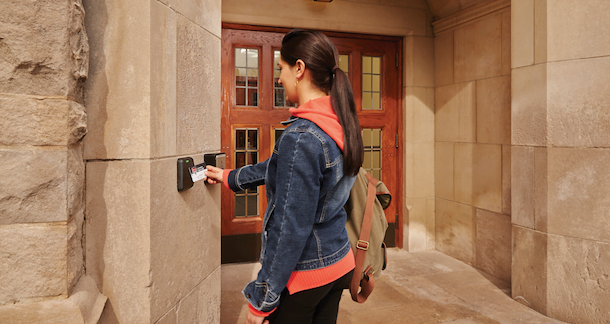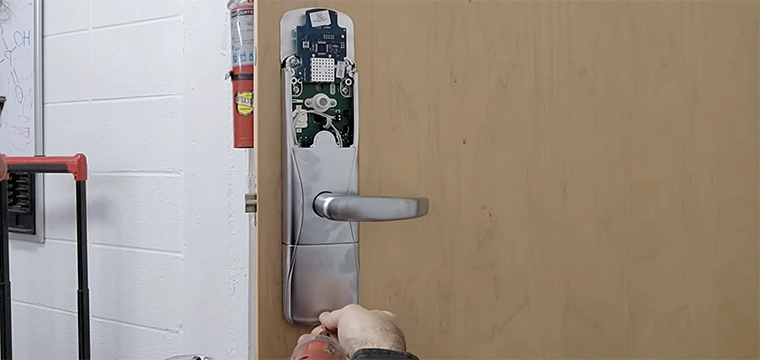
 By Jeff Koziol, Business Development Manager – PACS Partners, Allegion
By Jeff Koziol, Business Development Manager – PACS Partners, Allegion
As more college campuses adopt electronic access control each year, or expand what they already have, it’s important to have a handle on electronic access control 101 and how the technology can create a better campus experience for students, faculty and staff alike. Weighing campus security, convenience and cost are often at the forefront of discussion when considering upgrades.
Read on to learn the basics of electronic access control 101, key points to consider when assessing your campus’s needs, and benefits the different types of systems can provide.
Electronic access control refers to a wired or wireless system that determines access to entry points using software and access credentials. Student credentials may include ID cards, badges, fobs or mobile credentials in an app or the student’s Apple or Google Wallet. The user must present their credential to a reader, which then decides whether the user is authorized to access the entry point. It can also exclude entry at certain times or certain days.
Components that make up an access control opening include a card reader, latching hardware, door position indicator, a request-to-exit switch (a sensor that differentiates between someone forcefully entering, and someone exiting), and of course, a power source.
If you get a request to add electronic access control somewhere on campus, you first need to speak with an access control expert to determine your unique needs. One type of solution may not solve all your security requirements.
It’s important to have a holistic approach to each entry point and its environment. Then, these surroundings and existing conditions must be evaluated, including door type, frame type, ceiling access, and ability to retrofit existing hardware. This will help determine what type of electronic access control hardware will be best.
Based on these factors, a cost estimate is developed and presented. Once approved, necessary permits are secured, and orders are placed. More recently, however, labor and material shortages has impacted this step.
“We're at the mercy of what's available and how soon can you get it,” says Gary Conley, Access Control Project Manager at University of Virginia. “Once installation is scheduled, preparation crews are brought in to complete the project.”
When choosing which electronic access control hardware to implement, it comes down to preference of lock platform. “Do you want to go with an electric strike and couple that with a mechanical lock,” Conley asks. “If you're going with exit hardware, do you prefer to have exit trim where the exterior handle locks and unlocks, or do you need the flexibility of having electric latch retraction.”
Hardware selection depends on the door type, needs of the user, and application.
One consideration to account for is aesthetics. Electric strikes are used in conjunction with a card reader and connected to an integrated access control panel or a standalone controller. They are installed directly on the door frame.
“Some people don't like the look of electric strikes. They're kind of ugly,” says Conley. “Others prefer to go with an electrified lockset because you can't see anything.”
Wires must be run in the surrounding area which can disrupt the aesthetic or allow for tampering. Electric strikes can also create a “click-clack” sound upon opening and closing. However, they are easier and faster to install and to retrofit existing hardware. Electrified locksets transfer power through the actual hinges and door but require more invasive, expensive, and specialized installation.
The second consideration is anticipating any potential need for additional complementary hardware. When selecting the type of electric access control for the Student Health Center, Conley decided on a mechanism that could easily be combined with a power operator for wheelchair access in the future.
In less than a year, the Student Health Center requested 12-14 of those power operators, he says. If a power operator might be added in the future, an electric strike or electric latch exit device allows for such update.
There are certain openings that may be better suited for wireless locks due to budget constraints or the difficulty in getting cable or wiring to certain openings. Wireless, battery-powered locks have become commonplace on many university and college campuses for applications like student room entries, faculty offices, lab spaces and storage or data closets.
While these solutions tend to maximize the campus’s security budget and can tie into the security and access control software already in place on campus, these solutions carry considerations for annual maintenance costs, like battery change-outs.
Another important consideration is code compliancy. Factors affected by code include the type of door, like a fire door, the need for failsafe trim, and re-entry requirements.
For example, fire stair doors’ electric latch retraction must be programmed so if the alarm sounds, the latch retraction is released – but the fail-safe electric trim ensures that the hardware always remains latched on the exterior while still allowing egress in emergency. Conley notes that he and his staff stay up to date every week on iDigHardware, a blog from Allegion’s Lori Greene covering topics surrounding door, hardware, and code questions.
The final consideration is traffic flow. There's a significant balancing act between ease of use and being completely secure. “The most secure opening is the one you cannot get through,” says Conley.
While restricting a door with heavy traffic flow may feel inconvenient, it also provides valuable, additional security. Classrooms, laboratories, residence halls, and offices holding student records are a few spaces that benefit not just from limiting access, but auditing who accesses the space, and when.
Doors with less concern around traffic monitoring can benefit from prop and force alarms, which sound when the door is forced or left open. These alarms are easy and inexpensive to install and may be programmed to automatically silence when the door is closed again, making it a convenient option.
Convenience and security are major benefits of access control technology. With electronic access control, credentials can be instantly deactivated if reported lost or stolen. Whether an ID card or mobile credential, all it takes is the click of a button to prevent unauthorized people from accessing a secure space.
“We can literally say, ‘what's your card number?’” says Conley, whether he’s issuing access to a door or building, or revoking access. This helps to quickly secure sensitive areas or buildings where select people should be able to access, like residence halls, adding a more efficient layer of safety.
On the other hand, a physical brass key must be tracked down, or each corresponding entry point will need to be rekeyed. Losing a master key can cost tens of thousands of dollars to rekey entire buildings.
For transient populations like students, auditing brass keys becomes more complicated than keeping track of credentials tied to a database. Digital information is stored centrally, rather than in the hands of thousands of students in the form of small, brass keys.
However, the price tag of electronic access control can turn some away. Traditional keyed access is typically less expensive to implement up front without accounting for the potential need to replace keys or rekey doors. It’s typically easier to get ahold of and install the hardware.
The expertise required to install and maintain electronic access control may not be readily available. You not only need someone qualified to program the systems, but you also need someone that can properly structure the systems.
When deciding to implement electronic access control on your campus, it’s important to start with the fundamentals. Before ever considering implementing electronic access control hardware on campus, having every door in basic working order is essential.
This means the door itself, the hinges, the frame and the surrounding area must be maintained properly before introducing the hardware. If any portion of the door is not properly maintained, the access control system cannot do its most important job – restricting unauthorized access and providing security to the facility.
Securing your campus is not a one-size-fits-all solution. By seeking out industry experts and advice, you can work to create a customized access control system – whether traditional or electronic – to best fit the needs of every entry point on your campus.
Are you ready to implement electronic access control on your campus, but still not sure where to start? Discuss your unique needs with an Allegion expert at us.allegion.com.




